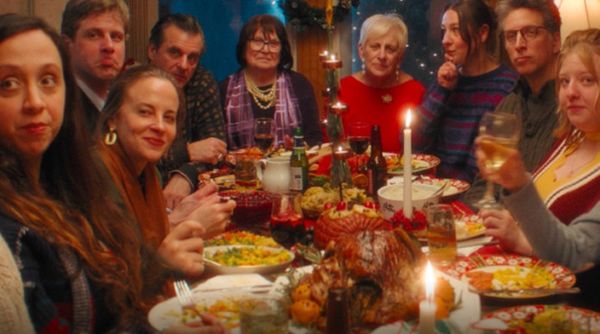Eye For Film >> Movies >> Christmas Eve In Miller’s Point (2024) Film Review
Christmas Eve In Miller’s Point
Reviewed by: Jennie Kermode

Some films are there to tell stories, some to explore themes. Some ask questions and some deliver messages. Tyler Taormina’s are there to be experienced.
Since the breakout success of Ham And Rye in 2020, Taormina has been gradually acquiring a cult following. Much of this has been through word of mouth because, frankly, his films are difficult to review, and they certainly don’t lend themselves to the snappy soundbite culture through which most are promoted. Once seen, however, they are hard to forget. That’s because they plunge the viewer into the centre of what feels like a complete world. Christmas Eve In Miller’s Point is no exception.

For many people today, Christmas is first and foremost about family, and here we find ourselves attending a family get-together. We reach it by way of an energetic, playful opening sequence which sees credits collide and veer around one another on the screen as we peer through car windows at suburban light displays. Careering past in the blackness of night, gaily distorted, they recapture some of the magic that one sees in such things as a child, though the shifting score sometimes hits discordant notes, as if signalling a darker aspect to the celebration. This mood will return from time to time as the night goes on, a hint of the shadow cast by all those lights. This is, in part, a film about mortality, a reminder that moments of joy and wonder are fleeting. There are hints of the uncanny, distortions of form, such as the shadow puppetry that Taormina presents, in the upper windows of the house that is our destination, to tell us that there’s a party going on.
Inside that house, the action takes place at multiple levels, adults standing or sitting to converse whilst a horde a children charges around, experiencing events in a very different way. A small shih tzu shelters underneath a chair but does not seem afraid. Everything is chaotic but, somehow, coordinated, like a complex dance which has been performed many times before so that now sobriety is no longer needed. The camera drifts through it at a leisurely pace, back and forth, up and down, taking in different details one might when wandering around drunk or half asleep. From these, story and meaning gradually coalesce.
The house belongs to an older woman who is no longer herself. it’s easy to be distracted, as most of the attendees are, so it might take you a moment to realise that, though she sits amongst them, she’s not really participating. She looks faintly sad, far away. When the others go outside to watch a parade, she’s left alone, her facing pointing towards a frosty window; whether she is looking through it or just at it is hard to say. Her son, Matty, has been caring for her for a long time and is at the point where he can’t go on with it. He wants to sell the house. This, then, would be the last of these annual gatherings. His siblings bicker about it. Taormina’s camera only ever lets us see part of what’s happening in any one space at any one time, and the future is similarly obscured. A strain of melancholy taints the festivities for some, but even as this talk of endings is going on, other stories are just beginning.
All the trappings of a family Christmas are here: cards and seasonal ornaments, a vast amount of food, well honed rituals. The names of the dead are recited before dinner and there are moments of stillness when one might think of James Joyce. The costume design is wonderful, both in the present and in the old home movies we eventually see played, the light from the flickering screen sparking off the children’s dental braces. When presents are opened, some of the younger children find the most exciting part of the experience to be the paper. An uncle persuades a teenager to read the latest chapter of his novel in a scene distorted by a gently fisheye lens. A mother and daughter fall out over who is closest to the rolls (and the former’s terror at the latter growing up). Carols are sung badly. Novelty mugs with ballerina handles pirouette in the microwave.
Taormina’s diagonal sliding transitions and still more playful techniques carry us out into the wintry world where some of the teenagers escape, meeting friends in a diner, trying to provoke mildly amused local junkies, trying to get their hands on illicit alcohol. There are moments in the trees and moments in the back of cars, teenage romance with varying degrees of ambition and ineptitude. Love blossoms amongst adults too, sometimes in unexpected places. Faint sirens sound in this comfortable suburban world but nobody is really looking for trouble on a night like this. The lighting is exquisite, using the traditional seasonal colours of red and green but subtly changing their meaning through context. In the morning, we know, all of this will look different again, but for now, we can be warm and together and find the best of humanity in its oddness, its particularity, its sense of the possible.
Reviewed on: 14 Nov 2024














